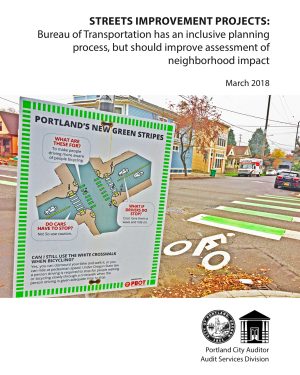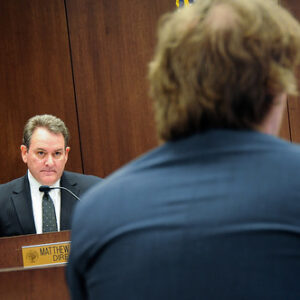
Projects completed by Portland’s transportation bureau are making streets safer, but the agency should do more to assess how surrounding neighborhoods are impacted by changes to traffic patterns.
That’s the key takeaway from a report released today by the Portland City Auditor.
The audit looked at 14 recently completed Portland Bureau of Transportation projects and selected two for closer analysis. They looked at safety projects on East Burnside (SE 15th to Laurelhurst Place) and on SE Division (from 60th to 80th). In both projects PBOT applied standard safety upgrades like lane reconfigurations, improved crossings and lower speed limits.
In both projects the City Auditor found that PBOT met their stated goals of safety and maintaining access to businesses.
However, the report says PBOT needs to take a closer look at what happens to adjacent streets and business patterns after projects are completed.
In the case of East Burnside, the audit says a 14 percent decrease in morning peak-hour auto volumes on the project street and a 117 percent increase in traffic on adjacent NE Couch means more analysis is needed to assess how that change affects local businesses and residents. “It would be important to know,” the audit states, “if they were adversely affected by the diversion of cars to adjacent streets.”
On Division, a lane reconfiguration and other changes led to a major decrease in crashes and the amount of speeding by drivers. Diversion to other streets wasn’t an issue; but the Auditor said PBOT needs to do an analysis of how the neighborhood was impacted.
Advertisement
Here’s an excerpt from the audit:
“As these two projects demonstrate, the Bureau uses measures to evaluate traffic safety and usage outcomes to determine whether some project goals were met, but had not developed indicators to measure livability outcomes. Determining how a project affected the neighborhood – such as whether businesses experienced an impact on their operations, what changes residents had to make to their commute, or how they accessed local shops and schools – may require management to commit resources to broader evaluation.”
And the recommendations are:
1. Develop and fund a consistent evaluation process that includes livability and neighborhood impact assessments
2. Use the results from project evaluations to inform the City’s future transportation plans and priorities.
PBOT Director Leah Treat has reviewed the audit and says they’re already working on the issue. “PBOT agrees that our project delivery process would benefit from additional measurement and evaluation practices.” Treat pointed to Portland Streetcar as an example of the type of reporting her agency would like to do. Streetcar publishes an annual report that’s easy to read and includes clear data about the impact of their impacts.
“We are taking steps to increase our ability to implement similar practices in PBOT project evaluation,” Treat wrote in the letter. “In the past year, the bureau has added additional positions that will help us increase these activities. Within the Business Services Group, we have created an Office of Strategy, Innovation and Performance. The development of improved project performance and evaluation metrics are part of their assigned activities but have not yet been formalized. This team currently has added two staff to date and is finalizing the hiring for a third.
In addition, PBOT recently added a Vision Zero Data Analyst position in our Policy Planning and Projects group to improve our evaluation of crash and overall safety and comfort performance data. This work will assist in project identification and scoping of improvements as well as evaluate improvements after they are implemented.”
Check out the Auditor’s report here (PDF).
— Jonathan Maus: (503) 706-8804, @jonathan_maus on Twitter and jonathan@bikeportland.org
Never miss a story. Sign-up for the daily BP Headlines email.
BikePortland needs your support.






Thanks for reading.
BikePortland has served this community with independent community journalism since 2005. We rely on subscriptions from readers like you to survive. Your financial support is vital in keeping this valuable resource alive and well.
Please subscribe today to strengthen and expand our work.
“what changes residents had to make to their commute” Heavens, a disruption of the norm!
Well, in the case of the the Springwater being closed for an entire third of this year, I’ve started investigating alternate routes. So far, all of them are slower, and drastically more dangerous. The worst of it was trying to use 17th, what I found was that the light at 99E is terribly imbalanced against anyone who isn’t in a motor vehicle.
What I’m saying is, I welcome anyone at PBOT taking a look at what the downstream impacts of their public works projects are.
Springwater is Parks Bureau, not PBOT.
PBOT “We’re putting in a protected bike lane and re-configuring the street in order to make it safer for pedestrians and cyclists”
Neighbors: “Oh, so the city is going to take away my parking for cyclists” or “The city is squandering scarce resources to make things more convenient for cyclists”
PBOT needs to change it’s messaging* to clarify that the street projects are being done because:
Automobile operators refuse to obey the speed limits.
People driving motor vehicles can’t keep their cars within the lines.
Drivers are making the streets unsafe.
Speeding cars are killing people.
It’s not about bikes.
*Particularly so given that enforcement is not longer in the tool kit for changing driver behavior. (Which sounds insane to me)
“no longer”
You folks need to get away from the cars versus bikes mentality. It’s about dog walkers – bike routes make it safer for you to cross a street with your canine-American pal Rex. Shape the conversation around walking the dog and you’ll be able to relate to your buddies at AAA, the neighborhood association, and PBA, rather than look like a less-than-intimidating yellow-jacket street gang.
The one thing that would help with both making our streets safer and mitigating negative impact on neighborhoods is reducing car traffic. So recommendation number 1 should be: Prioritize projects that reduce the modal share for people driving cars.
Reducing car traffic and reducing modal share are two different things. PBOT has no goal of reducing the total number of cars on our streets. Their 2030 plan has a lower mode share goal for single-occupancy motor vehicles, but a higher total number of trips made this way. I don’t often see these distinctions being made by PBOT, and have great fear about the future of transportation in our city.
I’d worry about the present. Both transit and bike mode share are **declining**.
True — so let’s amend recommendation number 1: Prioritize projects that reduce the number of people driving cars.
The point being that this would create a win-win in terms of safety and car traffic disturbance, but the auditors did not seem to think about it, or did not want to go that route.
This is interesting. I get the feeling that PBOT too often will frame a project as being beneficial for bikes, but it is really an excuse to get bikes out of the way. I have having an email conversation with a PBOT employee about the Greeley MUP project. PBOT proposes to close the southbound bike lane on Greeley between Going and Interstate and replace it with a barrier-protected MUP on the east side of Greeley. This is done to address the conflict where the bike lane crosses the on-ramp to 405. However, it also sends southbound bikes out of their way. It also creates a very narrow MUP that will very high speed differentials. The project also stops at the concrete MUP between Interstate and Greeley- it will make no improvements there. This path is less than 10-feet wide (barely, but it is less). It is used as an uncontrolled driveway by the residents of Hazelnut Grove, neighbors delivering stuff, and trucks servicing the dumpster and portable toilets. The connection between the existing MUP and the bike lane is a single curb where bikes will merge with on-coming, downhill-traveling bikes, next to traffic into a 5-foot bike lane; or exiting down the ramp to continue south while bikes heading north are trying to use it to continue north. Also, 2 of the driving lanes on Greeley will be 13′-14′ wide. When asked about the all of these safety conflicts, PBOT just says “great idea, not in the scope of this project”. They trade one dangerous condition for a bunch of new ones, but they succeed in getting bikes out of the way and speeding up an already too fast road.
260 cars per day is a 117% increase from 120 cars per day.
Lies, damn lies and statistics…